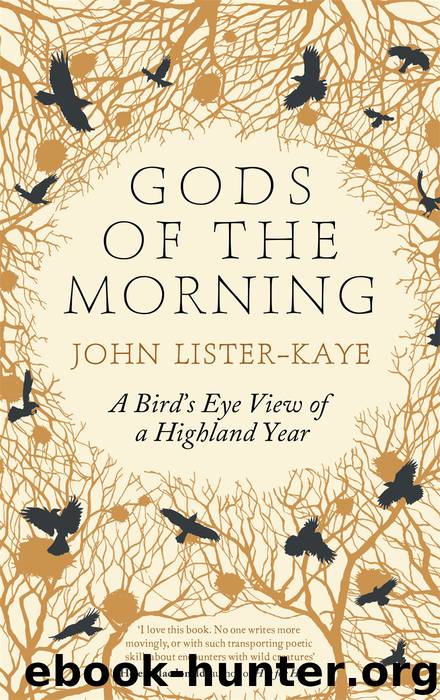1605987964 (N) by John Lister-Kaye

Author:John Lister-Kaye [Lister-Kaye, John]
Language: eng
Format: epub, mobi
Publisher: Canongate Books
Published: 0101-01-01T00:00:00+00:00
Somewhere out there, silent and secretive, is a pair of long-eared owls. We almost never see them. The western red cedars, planted in clumps 130 years ago and constantly spreading outwards by the furtive process of branches layering wherever they touch the ground, are now dark jungles of evergreen foliage on the outside, and impenetrable grottoes of dead branches and dark trunks looming up into the lofty canopy on the inside. They create perfect asylums for fell deeds and skulking beasts. A young male badger recently took up residence in a shallow dugout under the buttress roots of one massive stem. He had probably been ousted from his clan by a more dominant male and found a temporary home for himself under our trees. Roe deer sometimes lie up in these thickets, and pine martens and foxes slink in there to devour their filched chickens.
High above them, silently watching from a lofty perch, are the long-eared owls. This beautiful owl, with feather tufts (which aren’t ears at all), like extended eyebrows, reaching an inch above its head, is one of my problem birds. Every spring I search for them and mostly I fail to find them, although I do occasionally hear their deep, booming calls in the dead of night. In recent years I have seen only one, killed by a peregrine or a goshawk, stripped bare to the breast keel, lying on its back with spread wings on the heather moor. Whenever I have found their nest in the past it has always been because I have tracked down the unmistakable ‘squeaking-gate’ calls of the young. It is thought that they are universally in decline in the UK because of competition by tawnies. I haven’t found a nest for a few years now and if I don’t find another soon I shall begin to worry that ours have also been squeezed out.
Their diurnal cousin of the same genus, Asio, the short-eared owl, with barely visible ‘ear’ tufts, but which might better be called the long-winged owl (it has the longest wings of any British owl), is much easier to see. It wafts along the riverbank and across the marshes with slow, rowing down-beats, wavering glides and side-slips, more like a harrier than an owl. I used to see them regularly from my study window, a sight that always brought me to my feet, whatever I was doing, and still does, but less often now that agriculture has purified the pastures with Italian rye grass leys and the irrepressible craze for silage, so devastating to partridges, corncrakes, corn buntings and lapwings, as well as an unsung and unknown host of invertebrates. Even the once ubiquitous yellowhammers have given up and gone away.
It is a very confiding owl. If I stand still at the field edge it will hunt right up to and past me, sometimes perching on a fence post to quiz me from bright yellow eyes set in a bulging disc, giving it a slightly foolish look with an unnerving, baleful expression.
Download
This site does not store any files on its server. We only index and link to content provided by other sites. Please contact the content providers to delete copyright contents if any and email us, we'll remove relevant links or contents immediately.
The Lonely City by Olivia Laing(4731)
Animal Frequency by Melissa Alvarez(4382)
All Creatures Great and Small by James Herriot(4213)
Walking by Henry David Thoreau(3877)
Exit West by Mohsin Hamid(3765)
Origin Story: A Big History of Everything by David Christian(3631)
COSMOS by Carl Sagan(3539)
How to Read Water: Clues and Patterns from Puddles to the Sea (Natural Navigation) by Tristan Gooley(3386)
Hedgerow by John Wright(3259)
The Inner Life of Animals by Peter Wohlleben(3246)
How to Read Nature by Tristan Gooley(3231)
How to Do Nothing by Jenny Odell(3218)
Project Animal Farm: An Accidental Journey into the Secret World of Farming and the Truth About Our Food by Sonia Faruqi(3163)
Origin Story by David Christian(3132)
Water by Ian Miller(3112)
A Forest Journey by John Perlin(3018)
The Plant Messiah by Carlos Magdalena(2868)
A Wilder Time by William E. Glassley(2804)
Forests: A Very Short Introduction by Jaboury Ghazoul(2777)
